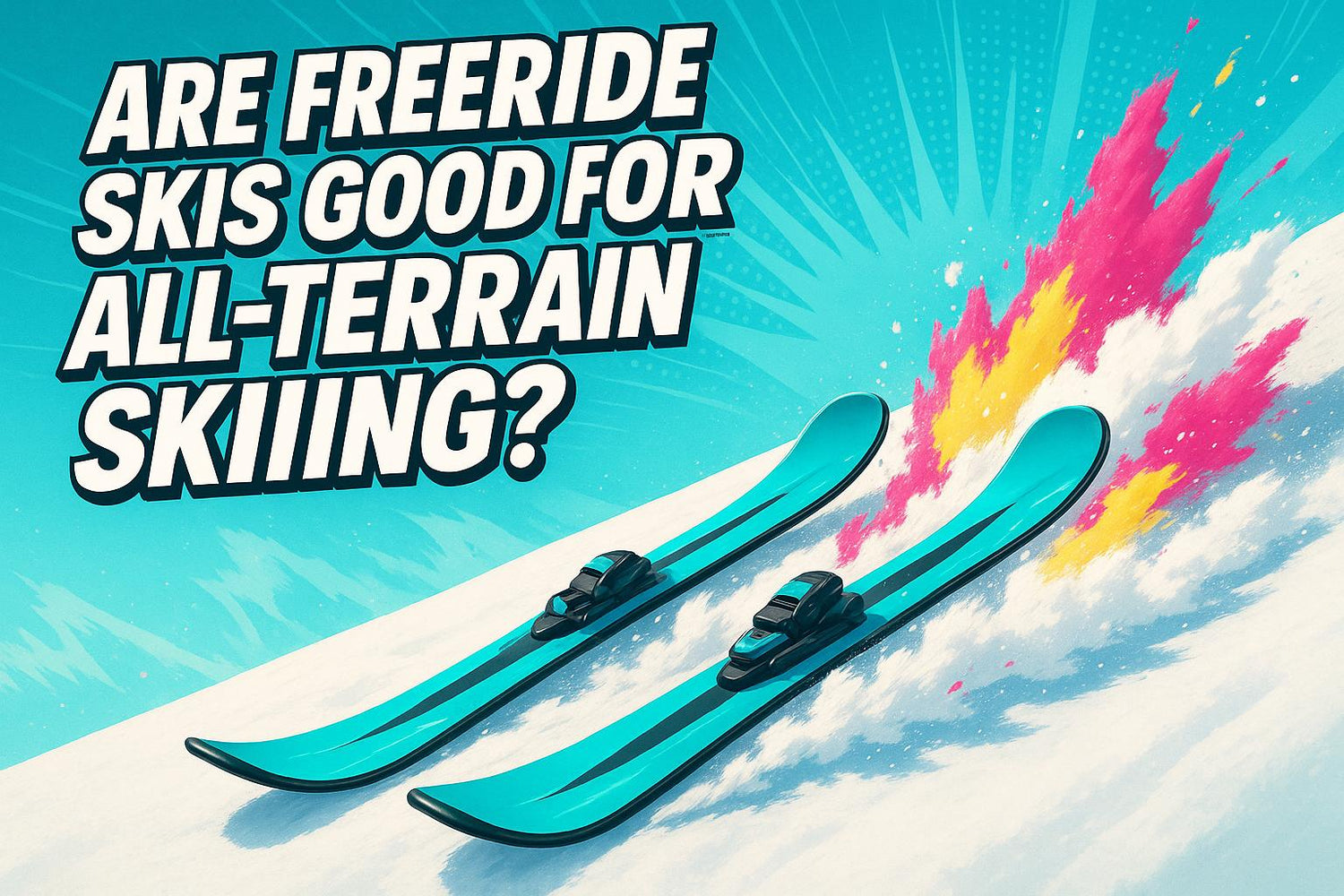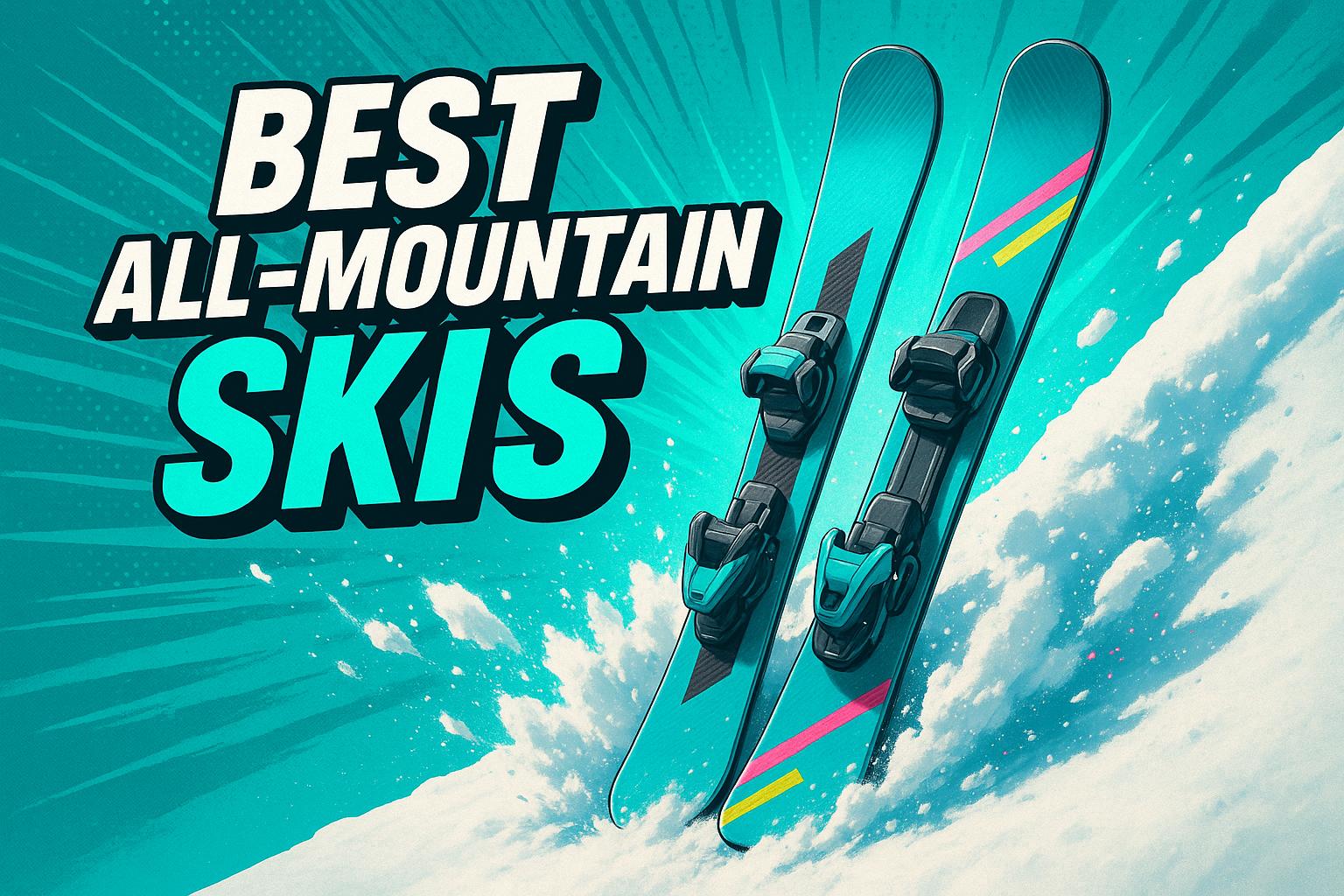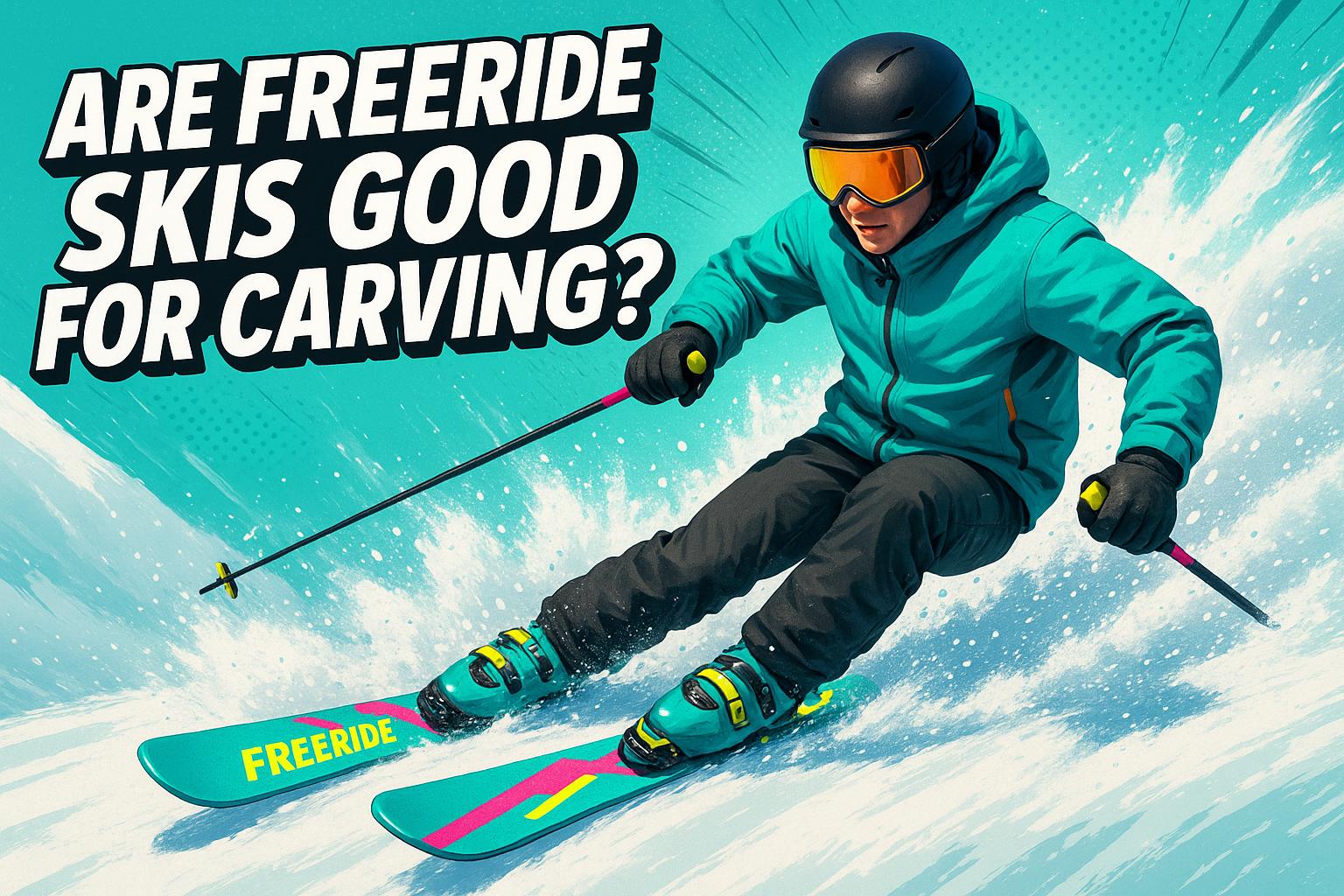Gli sci freeride sono fantastici per il POWDER ma presentano compromessi su piste battute e terreni stretti. Snowfeet, d'altra parte, offre un'alternativa compatta e leggera che funziona bene in varie condizioni ed è facile da trasportare. Nel frattempo, gli sci all-mountain offrono un'opzione equilibrata ma mancano di specializzazione in un'area specifica.
Ecco una rapida panoramica:
- Sci Freeride: I migliori per POWDER profonda, ma ingombranti e più difficili da controllare in spazi stretti. Costosi.
- Snowfeet: Compatti, accessibili e versatili. Ottimi sia per principianti che per sciatori esperti.
- Sci All-Mountain: Buone prestazioni generali ma non eccezionali in condizioni specifiche.
Se cerchi performance nella POWDER, scegli gli sci freeride. Per comodità quotidiana e terreni misti, Snowfeet è la scelta giusta. E se vuoi un'opzione intermedia, gli sci all-mountain potrebbero fare al caso tuo.
| Caratteristica | Sci freeride | Snowfeet | Sci All-Mountain |
|---|---|---|---|
| Prestazioni su POWDER | Eccellente | Buona | Discreta |
| Piste battute | Discreta | Eccellente | Buona |
| Portabilità | Scarsa | Eccellente | Discreta |
| Curva di apprendimento | Ripido | Facile | Moderato |
| Fascia di prezzo | $600–$1.200+ | $150–$690 | $400–$800 |
| Peso | Pesante | Ultra-leggero | Moderato |
| Manovrabilità | Limitato | Superiore | Moderato |
| Versatilità | Specializzato | Alto | Moderato |
Allora, quale si adatta al tuo stile? Immergiamoci!
I migliori sci del 2024! All-Mountain, POWDER, Freeride e altro!
1. Sci Freeride
Gli sci freeride sono pensati per affrontare la POWDER e il fuoripista. Se ti piace esplorare la neve intatta e avventurarti oltre le piste battute, questi sci sono fatti per te. Di solito misurano tra 90 e 115 mm sotto il piede, con alcuni modelli che arrivano fino a 125 mm, secondo Backcountry.com. Quella larghezza extra non è solo estetica: ti aiuta a galleggiare sulla neve profonda invece di affondare.
Design e Prestazioni
Gli sci freeride sono progettati con profili rocker, come rocker-camber-rocker o full rocker, che li rendono più facili da manovrare e riducono il bordo effettivo quando sei su piste battute. Per rendere questi sci più leggeri e facili da gestire, i produttori utilizzano materiali come fibra di carbonio e grafene. Questo aiuta a ridurre il peso oscillante, rendendo meno faticoso girare in spazi stretti.
Dove brillano
Questi sci eccellono nella POWDER. La loro base larga offre la stabilità necessaria ad alte velocità e possono anche cavarsela bene su piste battute. Detto ciò, la loro performance su pendii ghiacciati dipende dalla larghezza e dal design del bordo. Sci freeride più stretti, intorno ai 90–95 mm sotto il piede, sono più adatti a condizioni di hardpack, offrendo un po' più di grip e controllo.
Compromessi nel controllo
Ecco il problema: la stessa larghezza che rende gli sci freeride stabili in terreno aperto li rallenta quando cambi spigolo. Questo significa che richiedono più sforzo per essere gestiti in punti stretti e tecnici. Sono ottimi per ampi campi di POWDER ma possono risultare meno reattivi in terreni più confinati o impegnativi.
Costo e considerazioni pratiche
Gli sci freeride sono un investimento serio. Sono costruiti robusti per affrontare rocce e condizioni difficili, ma poiché sono ottimizzati per scenari specifici, potresti comunque aver bisogno di un secondo paio di sci per altri tipi di terreno. E non dimentichiamo l'aspetto pratico: trasportare e conservare questi sci può essere complicato. Di solito sono alti quanto te o fino a 15 cm più lunghi, quindi probabilmente avrai bisogno di portapacchi da tetto o di una sacca da sci per portarli in montagna. Inoltre, trovare spazio per conservarli a casa può essere difficile se hai poco spazio.
Il Punto Cruciale
Gli sci freeride sono perfetti per le giornate di POWDER e le avventure fuori pista. Sebbene siano migliorati nella gestione delle piste battute, rimangono strumenti specializzati. Se cerchi una soluzione tuttofare con un solo paio di sci, potresti dover valutare attentamente i compromessi. Ma per gli appassionati di POWDER, questi sci sono difficili da battere.
2. Snowfeet* Short Skis & Skates
Gli sci freeride dominano la scena POWDER, ma Snowfeet* sta rivoluzionando il tutto con un approccio fresco allo sci all-terrain. Invece di puntare su modelli più grandi e ingombranti, Snowfeet* si è concentrato su design compatti e intelligenti che prosperano in una varietà di condizioni di neve.
Design Che Si Distingue
Snowfeet* offre una gamma di prodotti, dai mini ski skates da 15 pollici agli skiblades da 39 pollici. Realizzati con materiale rinforzato in fibra di vetro e bordi metallici, questi sci sono progettati per precisione e durata. Il loro design brevettato ha persino ricevuto premi di settore di alto livello.
Una delle parti migliori? Funzionano con quasi tutte le calzature invernali. A differenza degli sci tradizionali che richiedono scarponi costosi e specializzati, l'attrezzatura Snowfeet* si aggancia a normali scarpe invernali o scarponi da snowboard. Questa caratteristica rivoluzionaria li rende accessibili e versatili per tutti i tipi di sciatori.
Prestazioni Versatili
Che tu stia scendendo piste battute o sfrecciando nel tuo cortile, i prodotti Snowfeet* gestiscono tutto. La loro dimensione compatta li rende perfetti per spazi stretti dove gli sci più lunghi sono scomodi. Non sorprende che vantino una valutazione di 4,9 su 5 stelle da oltre 5.500 recensioni verificate.
Facile da Imparare, Facile da Amare
Imparare a sciare può essere scoraggiante, ma Snowfeet* lo rende accessibile. La maggior parte degli utenti lo impara in circa un'ora. Fiona T. da Melbourne ha condiviso la sua esperienza:
"Il momento più divertente e piacevole che abbiamo mai vissuto sulla neve... così leggeri e facili da imparare dopo circa 1 ora di pratica"
Grazie alla loro lunghezza ridotta, questi sci permettono transizioni rapide da un bordo all'altro, offrendoti un controllo immediato. I principianti acquisiscono fiducia più velocemente, e gli sciatori esperti amano la reattività su terreni tecnici.
Compatto e Portatile
Dì addio ai portapacchi da tetto e alle borse da sci oversize. I prodotti Snowfeet* sono abbastanza compatti da entrare in uno zaino. Anche i più grandi skiblades da 39 pollici sono molto più facili da trasportare rispetto agli sci tradizionali, rendendoli ideali per viaggi spontanei o luoghi difficili da raggiungere.
Divertimento Economico
La differenza di prezzo tra Snowfeet* e gli sci freeride tradizionali è difficile da ignorare. Sci freeride di fascia alta come i Salomon QST o i Blizzard Sheeva 9 possono costare da 649,95 a 749,99 $. Snowfeet*, invece, varia da 150 a 490 $, con molte opzioni sotto i 400 $. Sono risparmi seri senza sacrificare le prestazioni.
Cosa Dicono gli Utenti
Le recensioni parlano da sole. Andrew B. lo ha riassunto perfettamente:
"Questi skiblades sono così divertenti e facili da controllare. Non tornerò mai più agli sci normali"
Versatilità Tutto Terreno
Mentre gli sci freeride brillano nel POWDER, i prodotti Snowfeet* offrono prestazioni costanti su tutti i tipi di terreno. Non sono limitati a un solo tipo di neve - sono fatti per sciatori che vogliono esplorare tutto. Che tu stia scivolando giù per le piste o giocando nel cortile, Snowfeet* dimostra che sciare bene non deve essere complicato o costoso.
sbb-itb-17ade95
3. Sci Tradizionali All-Mountain
Gli sci tradizionali all-mountain sono stati la scelta preferita dagli sciatori che vogliono un paio di sci in grado di affrontare varie condizioni. Sono progettati per offrire un mix di stabilità sulle piste battute e prestazioni decenti nella neve più morbida - una soluzione di compromesso.
Design e Prestazioni
Questi sci sono progettati per bilanciare due caratteristiche chiave: stabilità ad alte velocità e sufficiente galleggiamento per gestire la neve più profonda. Tuttavia, pur performando abbastanza bene in diverse condizioni, raramente eccellono in un'area specifica. Pensali come il "tuttologo" del mondo dello sci.
Sfide di Manovrabilità
Un aspetto negativo? La loro lunghezza maggiore può renderli difficili da gestire in spazi stretti. Curve rapide e transizioni brusche di spigolo possono sembrare un allenamento, specialmente su terreni stretti o irregolari.
Il Problema della Portabilità
Un altro problema è il loro peso e dimensione. Portare sci lunghi e pesanti può essere un fastidio, specialmente se la tua avventura prevede molta escursione. Come ha detto uno sciatore:
"Preferirei non trascinarmi un set completo di attrezzatura da sci per oltre 10 miglia, con più cime da scalare e chilometri di sentieri per 2.000 piedi di discesa"
Quando Funzionano Meglio
Gli sci tradizionali all-mountain sono al loro meglio su piste larghe e battute e per fare curve ampie e lunghe. Ma quando si tratta di portabilità e manovrabilità rapida - importanti per lo sci alpinismo o urbano - non sono all'altezza. Qui entrano in gioco alternative come Snowfeet*, che offrono un'opzione leggera e agile senza sacrificare il controllo.
Pro e Contro
Gli sci freeride, Snowfeet* e gli sci tradizionali all-mountain hanno ciascuno i propri punti di forza e debolezze. Scegliere l'attrezzatura giusta dipende dal tipo di esperienza sciistica che cerchi - che sia galleggiare nel POWDER profondo o navigare su piste battute affollate.
Gli sci freeride sono progettati per il POWDER e le avventure fuori pista. Il loro design più largo e lungo offre un'incredibile galleggiamento nella neve profonda, rendendoli perfetti per lo sci alpinismo. Ma c'è un compromesso: possono sembrare lenti sulle piste battute e sono più difficili da controllare in spazi stretti. Inoltre, il loro peso maggiore diventa una sfida durante le lunghe escursioni verso pendii remoti.
Snowfeet* è una rivoluzione nel mondo dello sci. Compatti e leggeri, sono incredibilmente facili da trasportare e offrono una risposta rapida. Il loro design più corto rende semplice fare curve strette e navigare su pendii affollati. Cambiare direzione sembra quasi senza sforzo.
Cosa c'è di ancora meglio? La curva di apprendimento per Snowfeet* è super gestibile. Mentre potrebbe volerci più stagioni per padroneggiare gli sci freeride, la maggior parte delle persone impara a usare Snowfeet* in poche ore. Questo li rende un'ottima opzione per sciatori di tutti i livelli di esperienza.
Gli sci tradizionali all-mountain, invece, offrono l'esperienza classica dello sci. Sono progettati per affrontare una varietà di condizioni ma non eccellono necessariamente in nessun ambito specifico. La loro lunghezza maggiore garantisce stabilità ad alte velocità, ma può renderli più difficili da gestire su terreni stretti o tecnici.
Ecco un rapido confronto di come si posizionano queste tre opzioni di sci:
| Caratteristica | Sci freeride | Prodotti Snowfeet* | Sci tradizionali all-mountain |
|---|---|---|---|
| Prestazioni su POWDER | Eccellente | Buona | Discreta |
| Controllo su piste battute | Discreta | Eccellente | Buona |
| Portabilità | Scarsa | Eccellente | Discreta |
| Curva di apprendimento | Ripido | Facile | Moderato |
| Fascia di prezzo | $600–$1.200+ | $150–$690 | $400–$800 |
| Peso | Pesante | Ultra-leggero | Moderato |
| Manovrabilità | Limitato | Superiore | Moderato |
| Versatilità | Specializzato | Alto | Moderato |
Quando si tratta di costo, Snowfeet* si distingue. Gli sci freeride di fascia alta possono costare oltre $1.200 prima ancora di aggiungere attacchi e scarponi. Gli Snowfeet* Mini Ski Skates, invece, partono da soli $150 e funzionano con i tuoi normali scarponi invernali. Anche i loro Short Skis premium da 120 cm, al prezzo di $690, sono più accessibili della maggior parte delle configurazioni tradizionali.
Un altro vantaggio? I prodotti Snowfeet* richiedono meno manutenzione. Gli sci tradizionali e freeride spesso necessitano di regolazioni regolari, mentre Snowfeet* mantiene le cose semplici. E non dimentichiamo la portabilità - gli sci tradizionali possono essere ingombranti e difficili da trasportare, ma Snowfeet* si adatta facilmente al bagaglio standard. Ciò significa niente costi extra per le compagnie aeree o portapacchi, rendendo le gite sugli sci spontanee molto più semplici.
Conclusione
Snowfeet* si distingue come un punto di svolta per gli sciatori americani in cerca di flessibilità e comodità sulle piste.
A differenza degli sci tradizionali all-mountain o freeride, che eccellono in aree specifiche ma deludono in altre, Snowfeet* colma il divario. Che tu stia curvando sulle piste battute a Vail, affrontando il backcountry dello Utah o semplicemente godendoti una giornata di neve locale, Snowfeet* è la scelta perfetta senza sforzo.
La loro dimensione compatta è un enorme vantaggio. Dimentica i portapacchi sul tetto o i costi extra per il bagaglio ingombrante nei voli. Stai pianificando una fuga veloce nel weekend in Colorado o Vermont? Basta metterli nel tuo bagaglio normale - nessuna disposizione speciale necessaria.
Per gli amanti del powder, lo Snowfeet* POWDER (99 cm) gestisce magnificamente la neve profonda offrendo comunque un controllo solido sulle piste battute. Se invece preferisci i parchi e le curve di precisione, gli Skiblades e gli Skiskates più corti offrono un'agilità impareggiabile che gli sci più lunghi semplicemente non possono garantire.
Un'altra caratteristica eccezionale? La curva di apprendimento rapida. Gli sci tradizionali spesso richiedono stagioni per essere padroneggiati, ma con Snowfeet*, molti sciatori si divertono a curvare con sicurezza dopo poche ore. Questo li rende un'opzione fantastica per le famiglie e per chi vuole passare più tempo a divertirsi e meno a faticare per imparare.
In definitiva, Snowfeet* elimina molti dei problemi associati agli sci tradizionali, offrendo un'esperienza snella e divertente su tutti i terreni. Non c'è da meravigliarsi se sono diventati la scelta preferita dagli sciatori che vogliono sfruttare al massimo il loro tempo sulla neve.
Domande frequenti
Perché Snowfeet sono una scelta migliore per lo sci all-terrain rispetto agli sci freeride o all-mountain tradizionali?
Snowfeet portano una ventata di novità nello sci all-terrain con il loro design leggero, portatile e versatile. A differenza degli sci freeride o all-mountain tradizionali, questi compatti ski-skates sono facili da trasportare, ideali per gli sciatori che danno priorità alla comodità. Inoltre, sono un'opzione economica che non sacrifica le prestazioni.
Uno dei vantaggi più belli? Puoi usare le tue scarpe invernali normali o gli scarponi da snowboard con loro - niente bisogno di quegli ingombranti scarponi da sci. Questo significa transizioni più rapide e accesso più facile alle piste. Che tu stia scivolando su piste battute, affrontando avventure fuori pista o zigzagando in spazi stretti, Snowfeet offrono un controllo e una flessibilità impressionanti che gli sci tradizionali non possono competere.
Cosa rende Snowfeet più facili da imparare per i principianti rispetto agli sci tradizionali?
Snowfeet sono un'ottima opzione per i principianti perché sono molto più facili da imparare rispetto agli sci tradizionali. Grazie alla loro lunghezza più corta e design semplice, sono meno intimidatori e offrono un controllo migliore. Questo significa che puoi concentrarti sull'equilibrio e sulla tecnica senza sentirti sopraffatto.
Gli sci tradizionali possono essere difficili per i principianti - sono più lunghi, più difficili da gestire e richiedono più pratica per essere padroneggiati. Snowfeet, invece, sono più indulgenti. Ti aiutano a costruire fiducia più rapidamente, rendendoli perfetti per chi prova gli sport sulla neve per la prima volta o cerca un modo meno impegnativo per scendere in pista.
Snowfeet sono adatti a tutti i tipi di terreno e come si comportano nel POWDER profondo?
Snowfeet funzionano alla grande su piste battute, tratti ghiacciati e POWDER leggero fino a circa 10 cm di profondità. La loro dimensione compatta ti dà un controllo eccellente, rendendo facili curve strette e manovre precise. Inoltre, sono super leggeri e facili da trasportare, il che li rende un'opzione incredibilmente comoda per affrontare le piste.
Detto questo, non sono progettati per il POWDER profondo. Gli sci all-mountain tradizionali, con le loro basi più larghe, gestiscono molto meglio la neve pesante, offrendo maggiore galleggiamento e stabilità. Mentre Snowfeet brillano per agilità e portabilità, sono ideali per neve compatta e POWDER leggero - non per affrontare discese profonde fuori pista.


































Lascia un commento
Questo sito è protetto da hCaptcha e applica le Norme sulla privacy e i Termini di servizio di hCaptcha.